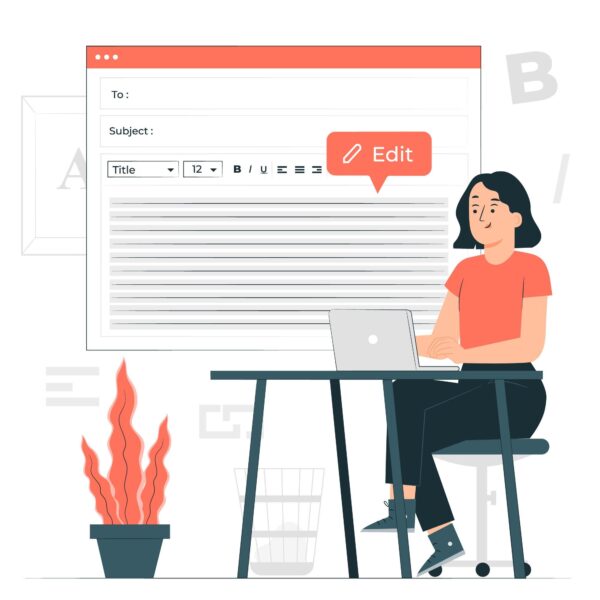User-Centric Messaging: The Meaning and Magic Behind UX Copywriting

Dolly Tomas | Jun 26, 2023
Reading Time: 7 minutesYou’ve seen it before – a beautifully designed website or app that’s visually stunning, but something just doesn’t feel right. The buttons, menus, and forms seem to be speaking a different language, leaving you confused and frustrated. That’s where UX copywriting comes in – What is UX copywriting, you may ask?
It is the secret sauce that not only makes digital products look good but also feel good to use. UX copywriting is all about putting you, the user, in the driver’s seat, giving you a sense of control and confidence as you navigate through digital experiences.
With clear, concise, and persuasive language, UX copywriters ensure that every interaction you have with a website or app is smooth, enjoyable, and, most importantly, effective in achieving your goals.
So buckle up and get ready to learn more about this essential component of digital design that’s all about empowering you to take control.
Defining What is UX Copywriting
Imagine effortlessly guiding users through your website or app with just the right words – that’s UX copywriting at its finest. As a UX copywriter, your primary goal is to create content that not only communicates your brand’s message effectively but also makes it easy for users to navigate through your digital products.
By using persuasive and engaging language, you ensure that your users feel in control and empowered to make informed decisions while interacting with your website or app. To excel in UX copywriting, it’s essential to put yourself in the users’ shoes and understand their needs, preferences, and pain points. This way, you can craft copy that resonates with them on a personal level, making their experience with your website or app as smooth and enjoyable as possible.
Remember, your users crave a sense of control, and by providing them with clear and concise information, you can help them achieve that. As you craft your UX copy, always keep in mind the importance of maintaining a consistent tone and voice throughout your content. This not only helps to establish your brand identity but also creates a sense of familiarity and trust with your users.
By focusing on clarity, persuasion, and engagement, you can create a user experience that leaves a lasting impression and keeps your audience coming back for more.
The Importance of UX Copywriting in Digital Design
You can’t underestimate the value of great wordsmithing in the realm of digital design, as it plays a crucial role in guiding users through a seamless and enjoyable experience. UX copywriting is the art of crafting the words and phrases that users encounter as they navigate a digital product, like a website or mobile app.
With the right words, you can help users feel empowered, in control, and confident in their actions, leading to increased satisfaction and, ultimately, brand loyalty. When it comes to UX copywriting, every word matters. Carefully chosen words can make all the difference in creating a smooth and intuitive user experience.
From button labels to error messages, UX copy must be concise, clear, and persuasive to guide users through each step of their journey. By understanding your users’ needs and anticipating their questions, you can craft copy that speaks directly to them, making them feel like they’re in control and that they can trust your brand.
The importance of UX copywriting in digital design cannot be overstated. It’s the thread that ties together all aspects of the user experience, seamlessly weaving together visuals, interactions, and information architecture.
When done right, UX copywriting ensures that users feel in control and have a positive experience with your digital product, ultimately leading to higher engagement, conversion rates, and brand loyalty. Don’t overlook the power of words to shape the user experience and elevate your digital design to new heights.
How UX Copywriting Differs from Traditional Copywriting
It’s crucial to recognize that there’s a world of difference between traditional copywriting and crafting words for user experience in digital products.
Traditional copywriting focuses on creating persuasive and engaging content, often for advertising or marketing purposes. The goal is to catch the reader’s attention, generate interest, and encourage them to take action.
On the other hand, UX copywriting aims to deliver clear, concise, and helpful information to users as they interact with digital products, such as websites, apps, and software. This type of writing helps users understand how to navigate, use, and benefit from these products with ease.
As you delve into UX copywriting, you’ll find that it requires a deep understanding of the user’s needs, expectations, and motivations. Your primary focus should be on guiding users through their digital journey, providing them with a sense of control and empowerment.
You’ll need to write clear and concise instructions, anticipate potential questions, and use language that resonates with the target audience. In contrast to the more persuasive nature of traditional copywriting, UX copywriting is all about providing users with the right information at the right time, leading to a smooth and satisfying experience.
When crafting UX copy, it’s essential to prioritize clarity and simplicity. Users want to feel in control and navigate digital products with ease, so avoid using jargon or complex language that may confuse or frustrate them. Instead, opt for straightforward language that communicates your message effectively while fostering a sense of confidence and trust.
By doing so, you’ll help users feel in control and create a positive experience that encourages them to continue using the digital product and, ultimately, achieve their goals.
Best Practices for Effective UX Copywriting
When striving for effective user experience writing, there are several best practices to keep in mind that’ll make your digital product more enjoyable and user-friendly.
First and foremost, prioritize clarity and simplicity in your copy. Users should be able to quickly understand your message and navigate your product with ease. Use concise language and short sentences, avoid jargon, and break complex concepts down into digestible pieces. Remember, you’re writing for a diverse audience with varying levels of expertise, so strive to make your copy accessible to everyone.
As you craft your UX copy, it’s essential to maintain a consistent tone and voice throughout your digital product. Consistency not only helps to create a cohesive brand identity but also makes users feel more at ease and in control. Think about how you want your users to feel while interacting with your product, and let that guide your tone.
You’ll also want to ensure that your copy is actionable and focused on the user’s needs. Use strong, active verbs and speak directly to your users by using contractions and pronouns like ‘you’ and ‘your.’
Don’t forget to test and iterate your UX copy. Regularly gather feedback from users, whether it’s through usability testing, surveys, or direct conversations. Analyzing user feedback will help you understand what’s working and what’s not and how you can improve your copy to better serve your users’ needs.
Always be willing to revise and refine your copy based on the insights you gather, and view UX copywriting as an ongoing process rather than a one-time task. By following these best practices, you’ll create engaging, user-friendly copy that empowers your audience and keeps them coming back for more.
Examples of Successful UX Copywriting in Action
Seeing successful examples of user experience writing in action can provide valuable insights and inspiration for crafting your own compelling digital content. Let’s explore some well-known instances of UX copywriting that have made a lasting impression on users and ultimately contributed to the success of these brands.
Take Mailchimp, for example. Their UX copywriting is conversational, friendly, and focused on making the user feel in control. When you send an email campaign through Mailchimp, a message appears saying, “High five! Your campaign’s on its way to your subscribers.”This simple yet effective message not only confirms the action but also celebrates it, making the user feel accomplished and in control of their marketing efforts.
Similarly, Slack’s onboarding process is another shining example of UX copywriting done right. With clear, concise, and engaging copy, users easily understand how to navigate and use the platform. Slack’s approachable and helpful tone encourages users to explore the app further and builds confidence in their ability to use it effectively.
One more example worth mentioning is Headspace, a meditation and mindfulness app. Headspace understands the importance of creating a calming and supportive atmosphere for its users. The copy is written in a soothing and empathetic tone, making the user feel at ease and in control of their mental well-being. Phrases like “Take a deep breath” and “You’re doing great” reinforce the user’s sense of accomplishment and control.
These examples demonstrate the power of well-crafted UX copywriting in enhancing the user experience, building brand loyalty, and ultimately driving success. So, next time you’re working on your own digital content, keep these successful examples in mind and strive to create an engaging and empowering experience for your users.
Frequently Asked Questions
What qualifications or skills are necessary to become a successful UX copywriter?
To succeed as a UX copywriter, you’ll need strong writing skills, empathy for users, and a solid understanding of UX principles. Master persuasive and engaging writing while adapting to diverse target audiences for optimum results.
How can one measure the effectiveness of UX copywriting for a specific project or application?
To measure the effectiveness of your UX copywriting, track user engagement, conversion rates, and user feedback. Analyze A/B testing results, time spent on pages, and drop-off rates to ensure your copy resonates with users.
Are there any tools or software that can assist in the UX copywriting process?
Absolutely! Tools like Grammarly, Hemingway Editor, and Readable can help you craft compelling UX copy. They’ll analyze your writing, offer suggestions, and ensure your content is clear, persuasive, and engaging for users.
How can UX copywriters collaborate with other members of a design team, such as UX designers and developers, to ensure a cohesive user experience?
Collaborate closely with UX designers and developers, sharing ideas, feedback, and insights. Together, create a unified vision, ensuring seamless user experiences. Embrace open communication, prioritize user needs, and celebrate each other’s expertise for successful collaboration.
What are some common challenges faced by UX copywriters and how can they overcome these obstacles?
As a UX copywriter, you’ll face challenges like tight deadlines, complex jargon, and collaborating with various team members. Overcome these by staying organized, simplifying language, and fostering open communication within your team.
Conclusion
So, you’ve got the scoop on what is UX copywriting; and its vital role in digital design. It’s all about crafting user-focused content that enhances their experience and guides them through your product seamlessly.
Don’t forget to follow best practices and take inspiration from successful examples. Now, go ahead and make your mark in the world of UX copywriting. Your users will thank you for it!



Table of Contents
Defining What is UX CopywritingThe Importance of UX Copywriting in Digital DesignHow UX Copywriting Differs from Traditional CopywritingBest Practices for Effective UX CopywritingExamples of Successful UX Copywriting in ActionFrequently Asked QuestionsTable of ContentsAbout the authorLeave a Comment Cancel ReplyAbout the author
Dolly Tomas
Dolly, Revenue Optimization Expert at Build Grow Scale! With a wealth of experience in eCommerce and an extensive background in Customer Service as an Operations Manager, Team Leader, and Project Manager, she's got the secret sauce to boost your bottom line. Armed with a Bachelor's degree in Electronics and Communications Engineering, she's a master of numbers and problem-solving. Balancing her professional achievements with her cherished role as a devoted mother to two cute kiddos, Dolly shows her unwavering commitment to driving revenue growth and her ability to navigate complex challenges make her an invaluable asset to any organization.




